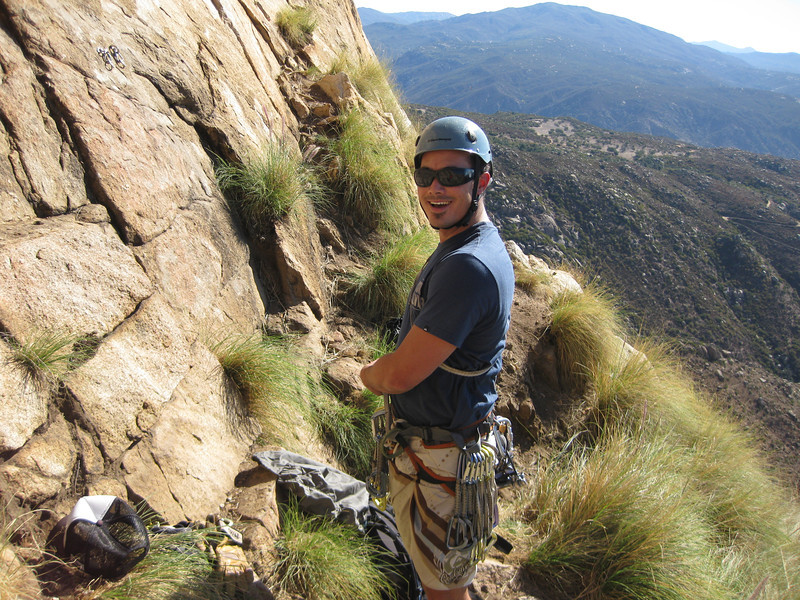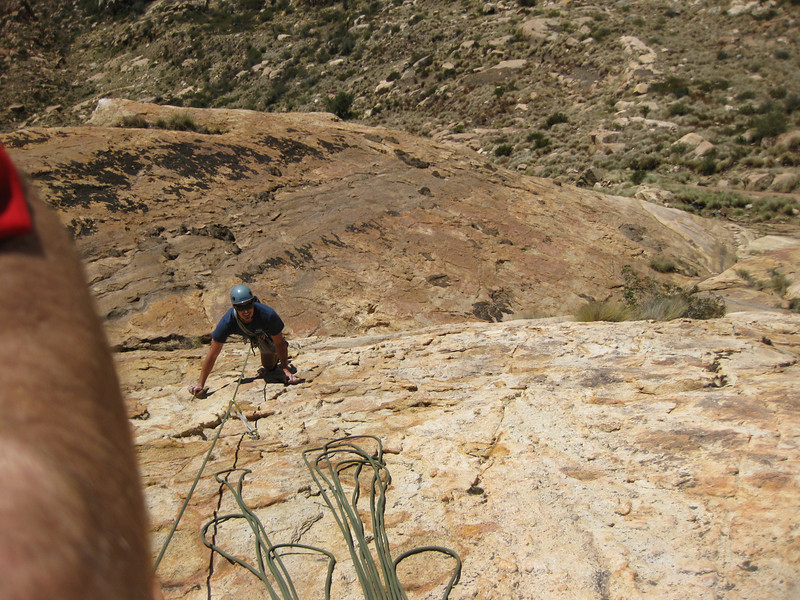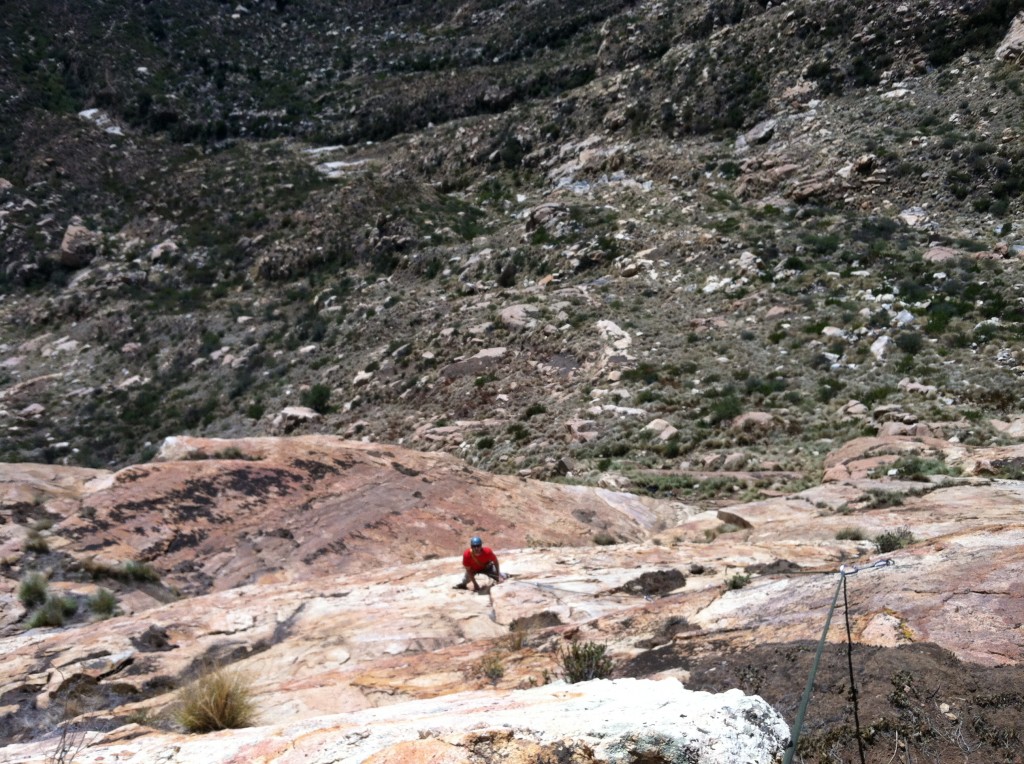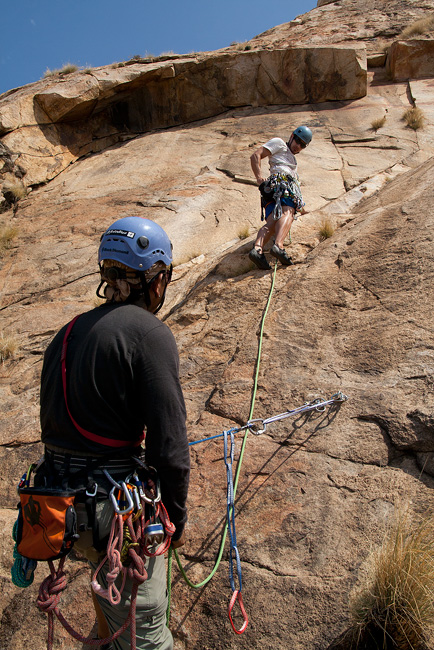Double post here, after back-to-back weekends at El Cajon Mountain. The last time we climbed at El Cajon, it was 90+ degrees and I almost died from heat stroke. Serious dehydration by the end of the day, since it took us longer than expected to climb Leonids. On this trip, Ryan and I brought plenty of water and we climbed Buffalo Brothers (5.8) with better efficiency. I led the first pitch; easy 5th-class up a dirty ramp to an anchor. A bit runout, but low-angle and pretty comfortable. Ryan followed and then led the second pitch, which involved some tricky moves onto the exposed face above. I don’t know if I would necessarily call it a blunder, but we both neglected to consider clipping one of the anchor bolts as the first piece of protection (thus eliminating the possibility of a factor-2 fall). There is a lot of debate about the pros and cons of such a move, but I think it is wise to clip into a bomber bolt in a situation like this. Doing so reduces the force of an early leader fall, and it also keeps the belay device oriented in the normal direction, should the climber fall past the belay anchor. I’ve never caught a really hard fall, let alone a bona fide factor 2 fall. I can only guess how difficult it would be to catch such a fall if my device became inverted, requiring that I pull the brake strand up towards my chest. It’s one of those situations that 99% of climbers will never experience, but I want to be sure I’m able to catch the leader 100% of the time.

And these are just some of the joys of multi-pitch climbing. I really love it; there’s something very satisfying about climbing so high off the ground. But there are a bunch of safety concerns that are rarely an issue in single-pitch climbing.
I am a bit of an information geek. I must own close to 20 different books on climbing anchors and methods. I have spent countless hours perusing the online forums at the popular climbing websites. Sadly, I spend way more time reading about climbing than I do climbing. On the forums, the signal to noise ratio is pretty low, but it doesn’t take long to figure out who is knowledgeable and worth reading. I particularly enjoy the anchor threads (pros and cons of the ‘olettes’ ad nauseum) and the accident/incident analysis. I don’t think there is any substitute for real climbing (spend less time reading and more time climbing) but I have learned a few tips and tricks that, I believe, make me a smarter and safer climber. And with my busy schedule, I can only get outside so much.
I also see the enormous benefit of learning from a crusty old mentor, but there is something fun and challenging in advancing through the grades with a partner at the same level. I’ve always been this way, preferring to figure things out on my own. Of course, a mistake in climbing can carry a very different set of consequences than do photography or reef keeping.

One of my mentors is Rich Goldstone, though he doesn’t even know it. He’s a regular contributor to the online forums and I have literally (and almost obsessively) searched out all his posts, gleaning as much information as I can. Rgold, as he is known within the online realm, is ~70 years old and continues to climb harder than I ever will. From what I’ve gathered, he’s a math professor in NYC and a Gunks local, with an impressive resume of hard climbs that goes back 50+ years. What really sets Mr. Goldstone apart from the rest of his peers is his knack for writing. There are lots of very knowledgeable climbers in this world, and some of them even bother to participate on the forums, but Goldstone does it best, hands down. He is a strong advocate for belay gloves, he holds pulley assist systems in dubious regard, and he makes a strong case for building anchors with the rope. He’s also a fan of using double ropes and does not use a rappel backup. I suspect that I might try double rope technique, eventually. As for the rap backup, I am definitely an enthusiastic fan and I think the pros outweigh the cons.

Back on topic, though. So Ryan and I managed to complete our 3-pitch climb in decent time, and we refined our systems a bit. There’s a lot of rope and anchor work involved in a long climb like this, and rapping back down (safely) can become a tedious headache. We did well, and I have no doubt that we will move even faster as we gain more experience.
The very next weekend, I needed a belay slave and to my surprise, Steve agreed to join me. I wasn’t really sure what we should climb, since this would be Steve’s first shot at giving a lead belay. I wanted to do something challenging, but that didn’t seem prudent.
We got up to the base and decided on Bright Eyes (5.6), a 2-pitch mixed route that I’ve done a couple of times before. I’ve probably top-roped with Steve close to a hundred times, and I trust his belay. But this would be a little different, and he’s never used a Gri-Gri before. I couldn’t decide if it would be better to go with the ATC, which he was familiar with, or the Gri, which would (in theory) give me an added layer of protection. I opted for the Gri.
Instead of following the bolted start that leads into the chimney, I decided to try the variation that traverses below a big roof. The alternate start goes at 5.8 and looked very protectable, but I could tell that the sustained undercling with insecure feet was going to be interesting. I’ve only done a few 5.8 trad climbs, with almost all my other leads on easier fare.

I scrambled up loose, dirty ledges for the first 20 feet. Standing on grass-covered footholds did not inspire confidence, but I reached the crack soon enough, and started searching for my first placement. Nothing! The crack was loose and rotten and nothing looked good. So I threw a sling over a little horn and clipped the rope. The sling was pretty marginal, but hopefully good enough to protect my next few moves into the crack. There, I was able to set a bomber cam and a nut, and I back cleaned the sling, which looked pretty pathetic.

I placed 5 or 6 pieces along the traverse. The climbing wasn’t terribly strenuous, but the feet were slippery and I was definitely concentrating. I wanted to send this thing clean, and I really wanted to avoid a fall. I wondered if Steve, who was belaying and about to follow his very first pitch on gear, had any idea what he had gotten himself into. I did my best to protect the second from a pendulum, but I didn’t want to run out of pieces for the anchor, either. I made it to the chimney safely, and my heart rate settled down.
I slotted a nut and my gold camalot in one side of the chimney, and then my red #1 in the right side. All three pieces were bomber. Unfortunately, I had left my cordelette in the car (wasn’t planning on building any trad anchors), so all I had left were some long runners, and the rope itself. I would have gladly used the rope – in fact I’ve been practicing different rope anchors at home – but that would have gotten complicated since I would be leading the second pitch. I threw a sliding-x on the left pieces and then extended the right cam so that the angles would be kosher, and tied everything off using another sliding-x for the masterpoint. I brought Steve up using my ATC Guide, and things went smoothly enough – except for the nut that he dropped and the two pieces of gear he was unable to clean.
I had plenty of time to evaluate the anchor as I hung there. This was, without a doubt, the most exposed trad anchor I’ve ever built. No real stance, the potential for a pendulum fall from a weird angle, and tricky moves into the chimney above. I decided that, though the anchor was solid, it could have been a lot better. I should have placed an additional directional piece in the crack at right, which would have protected the anchor as a whole from a strong sideways pull, which is exactly what would have happened if Steve had blown those last few moves. I also should have set the limiter knots closer to the masterpoint.

Steve was unable to clean the nut you see above, and I gave it a good 10 minutes of whacking and yanking, to no avail. There is now a piece of fixed gear in Bright Eyes, I am sad to report. I would be amazed if anyone is able to get that sucker out, but some people are magicians at that sort of thing. I would gladly go back up there with tools to either bury it deeper (out of sight) or just cut the cable, but I’m not sure what the ethics dictate. I’ll probably wait a while to see if anyone is able to clean it. Good luck.
